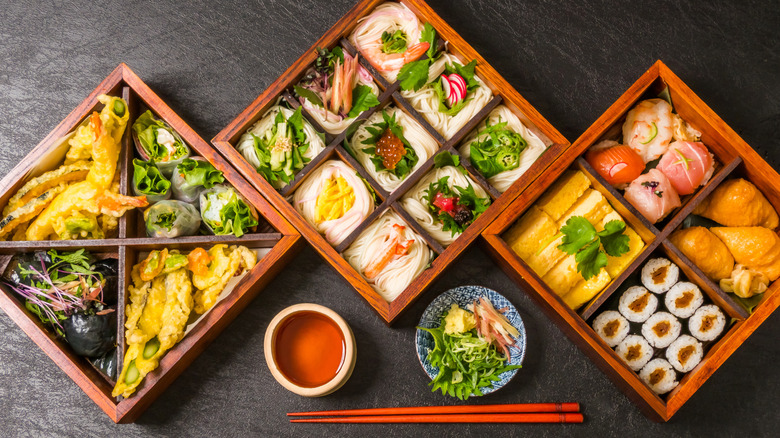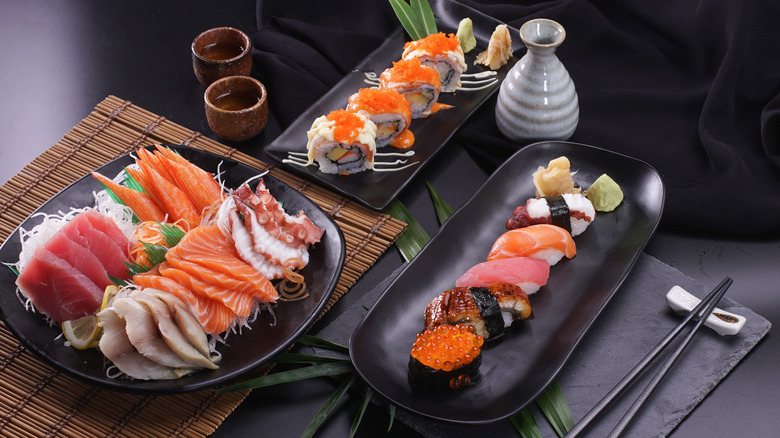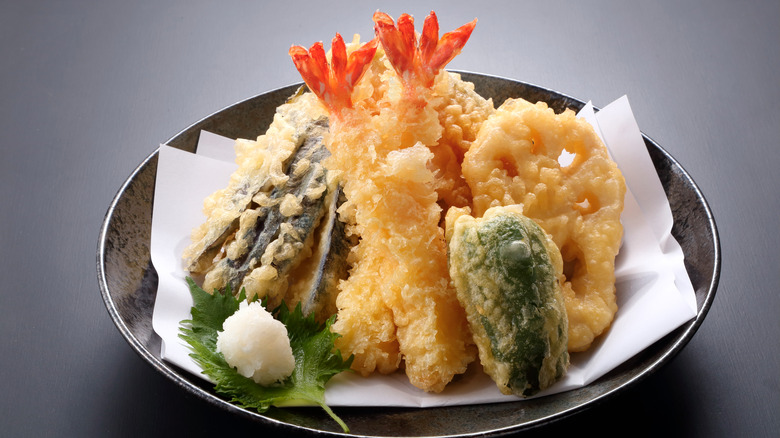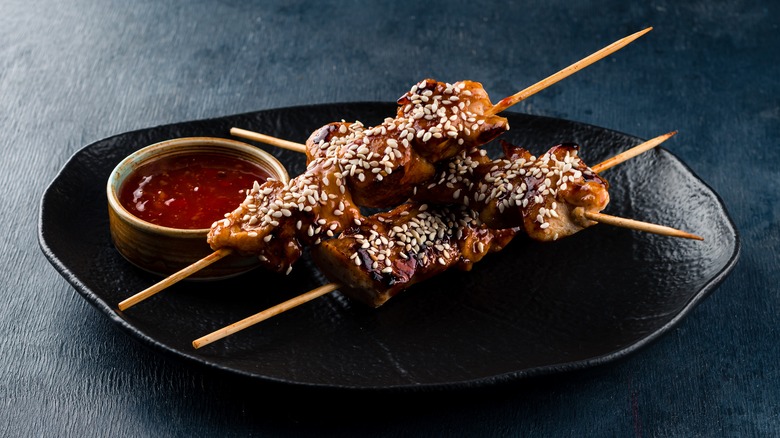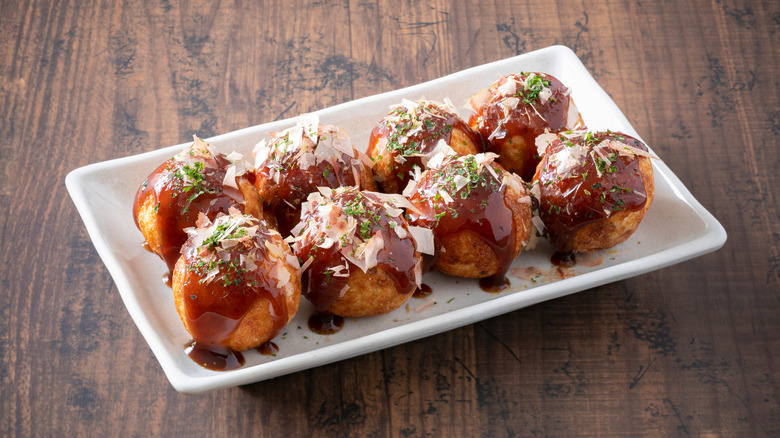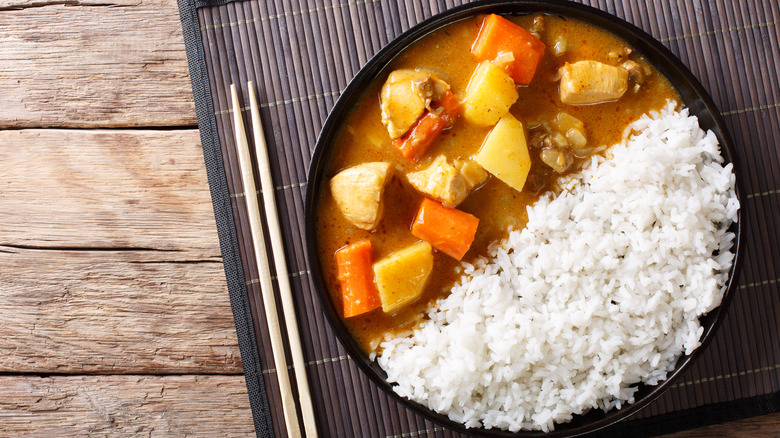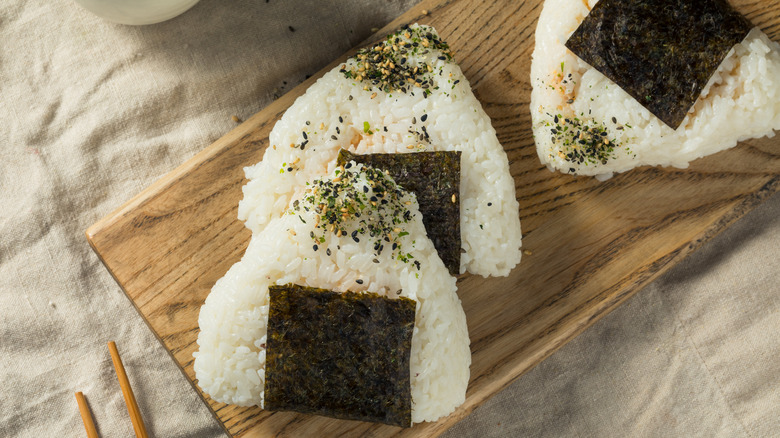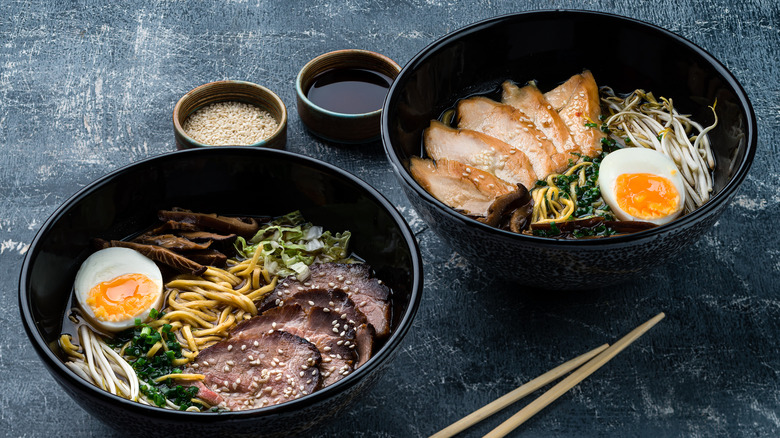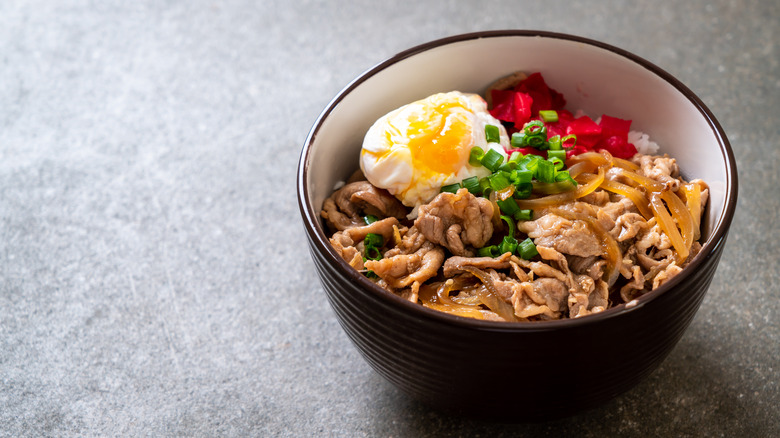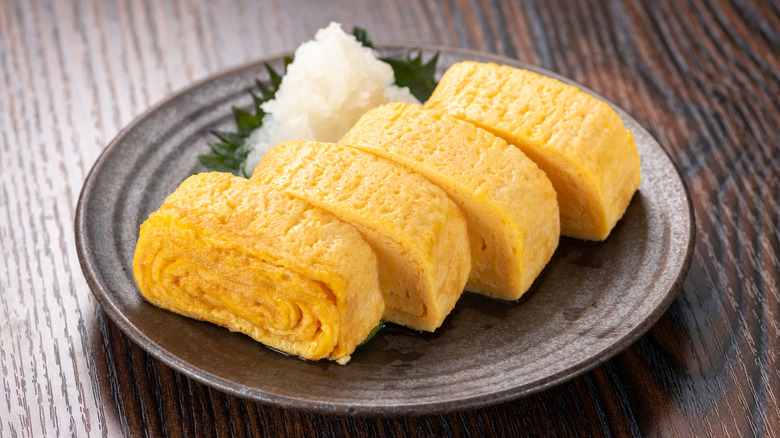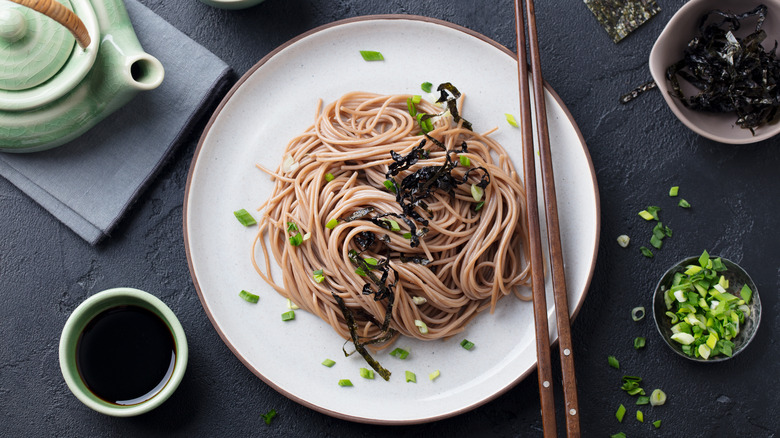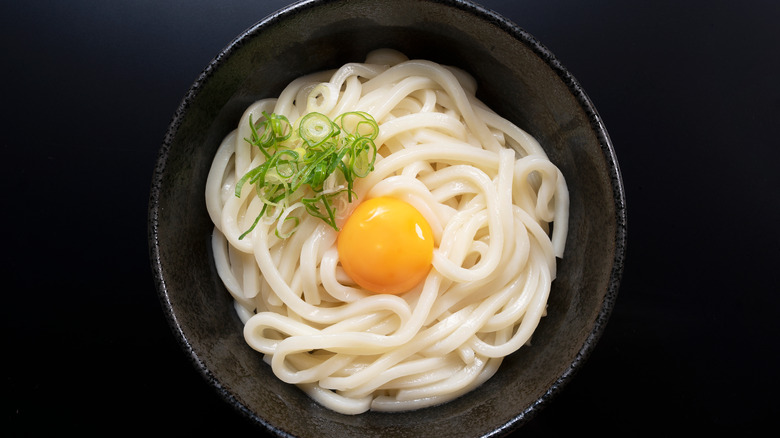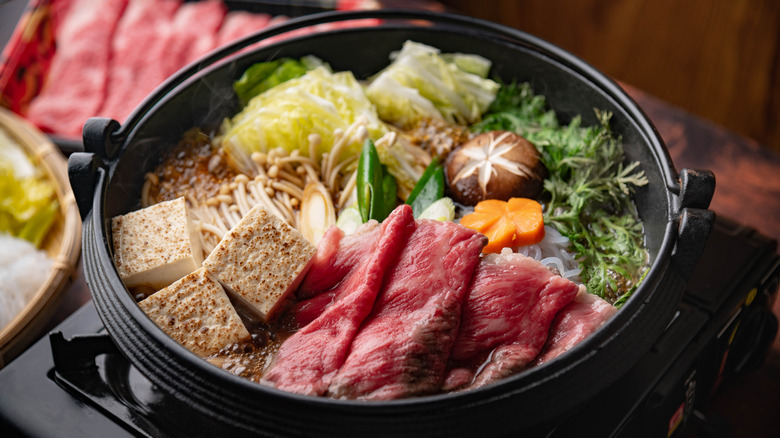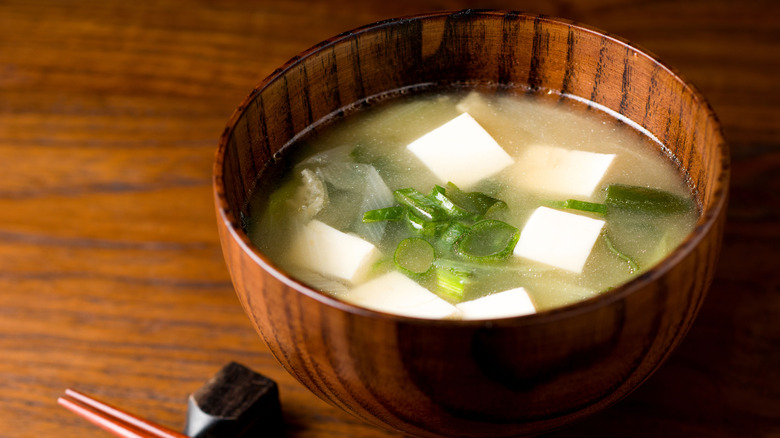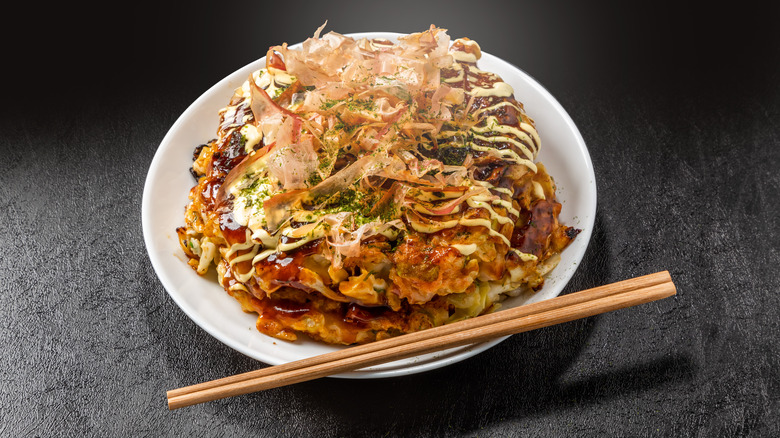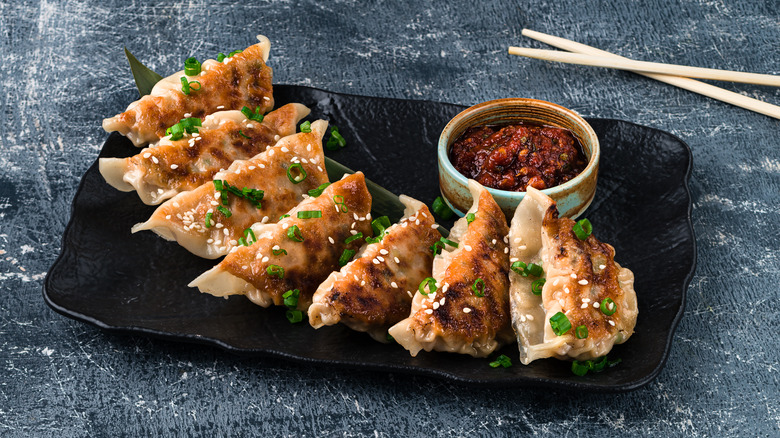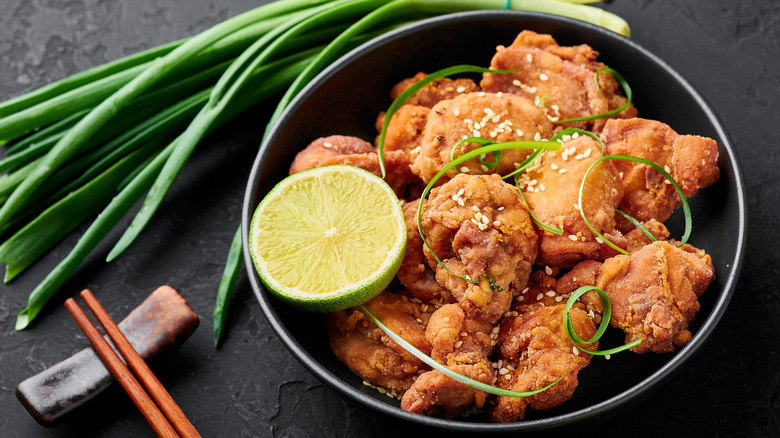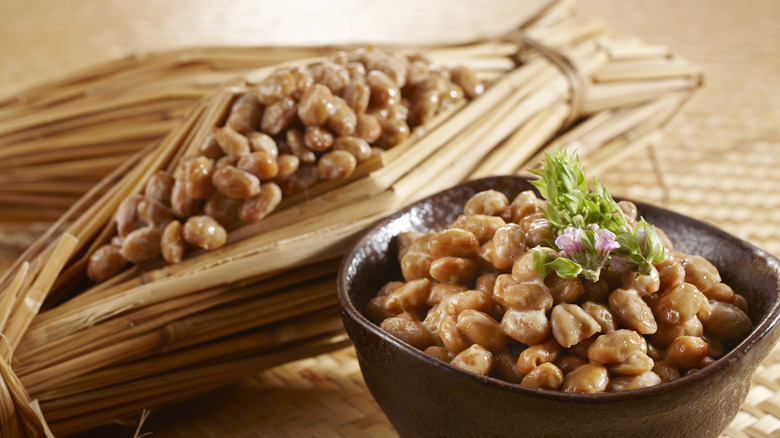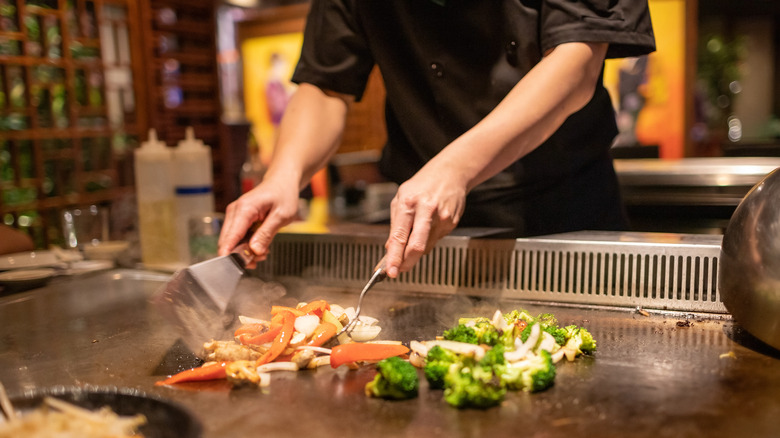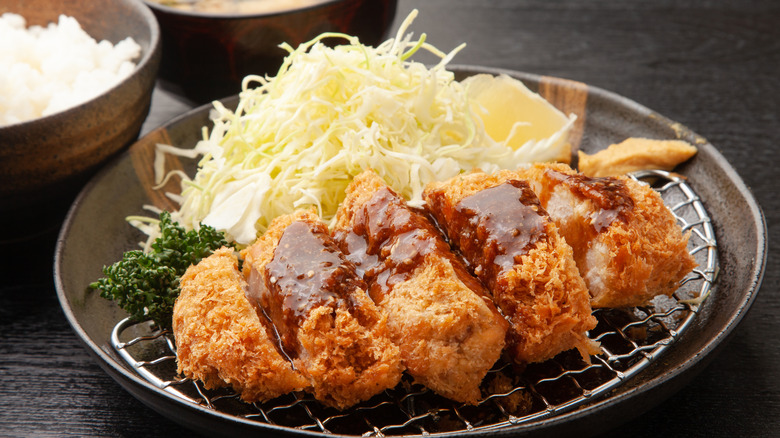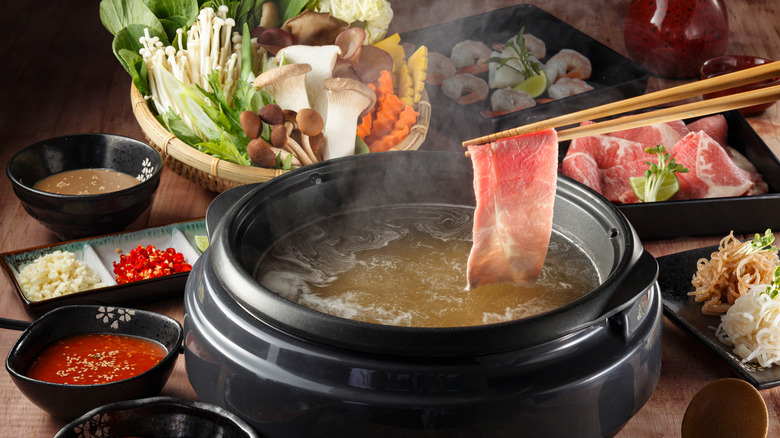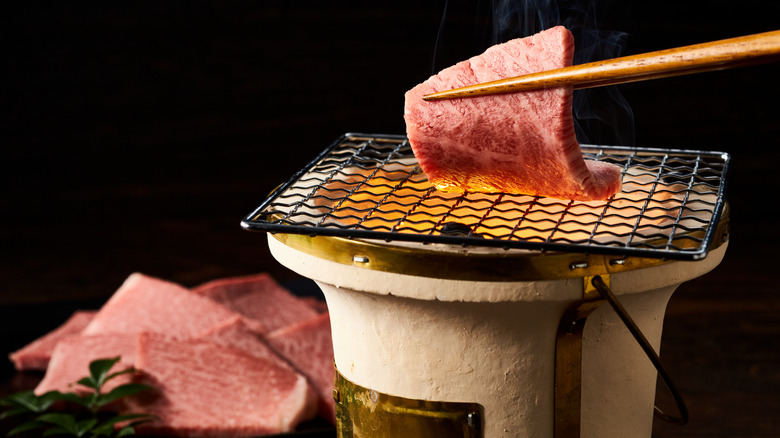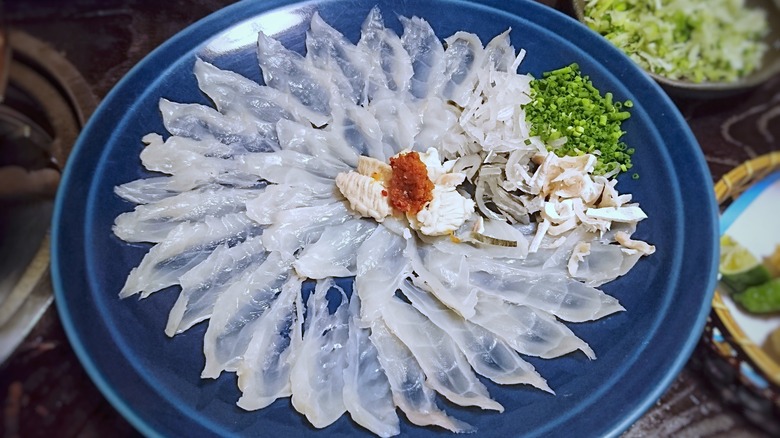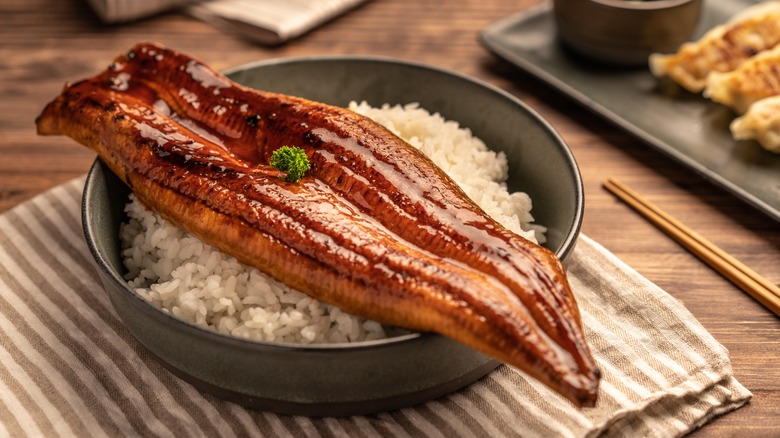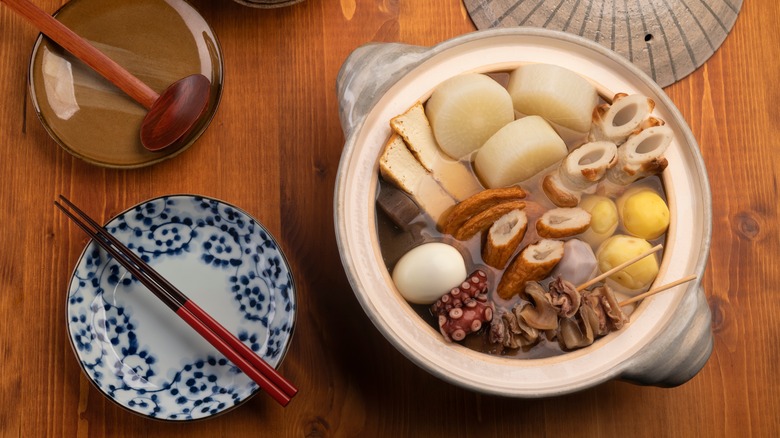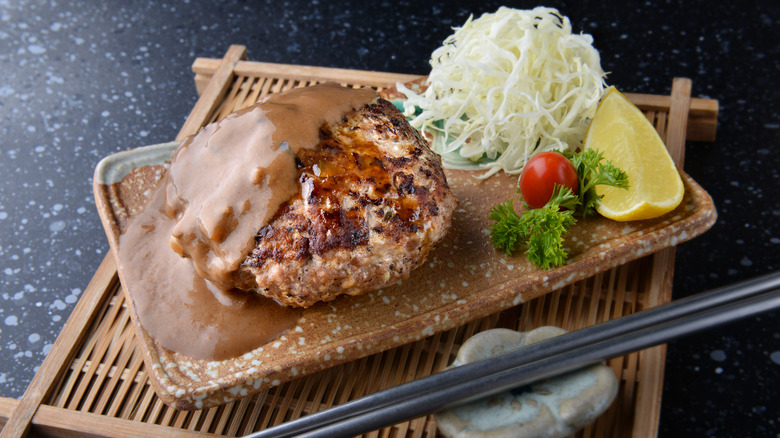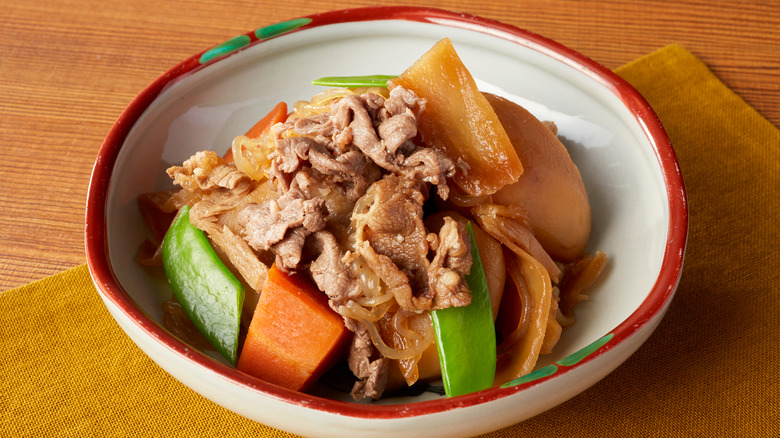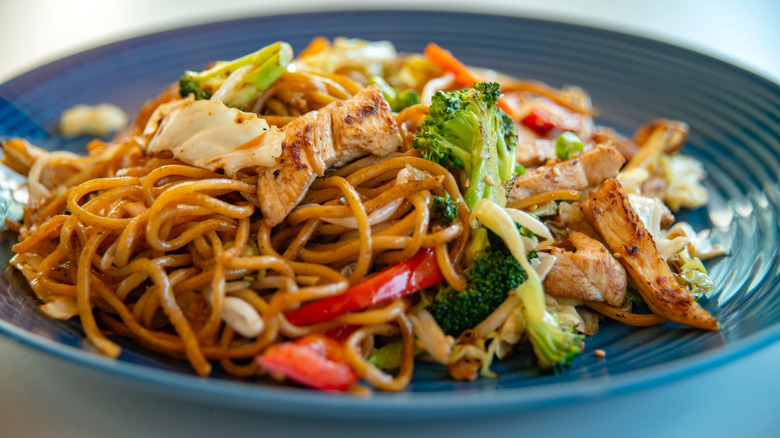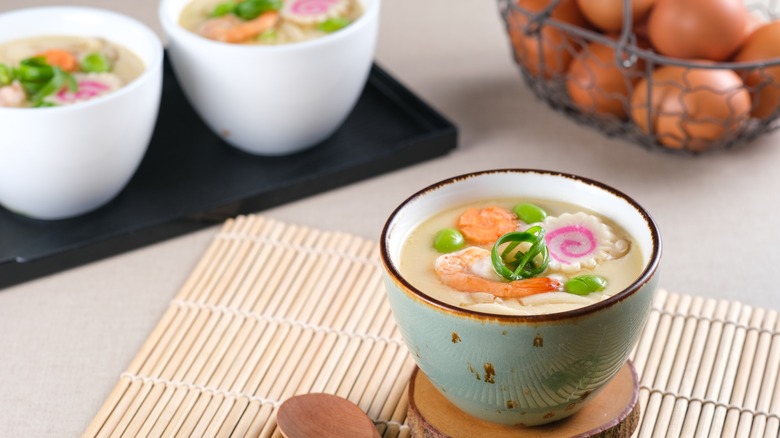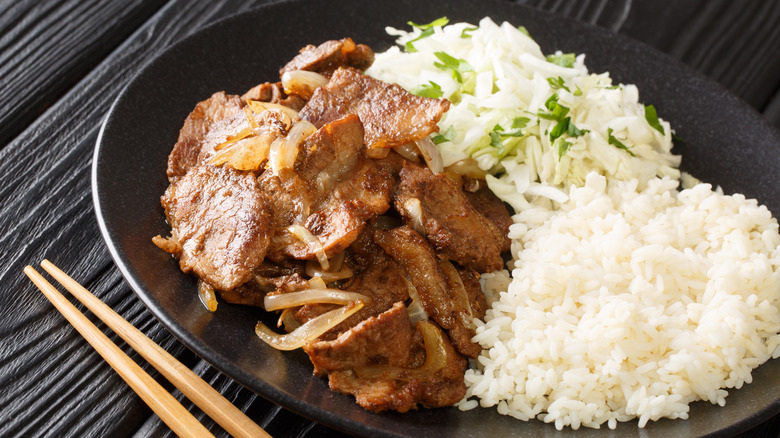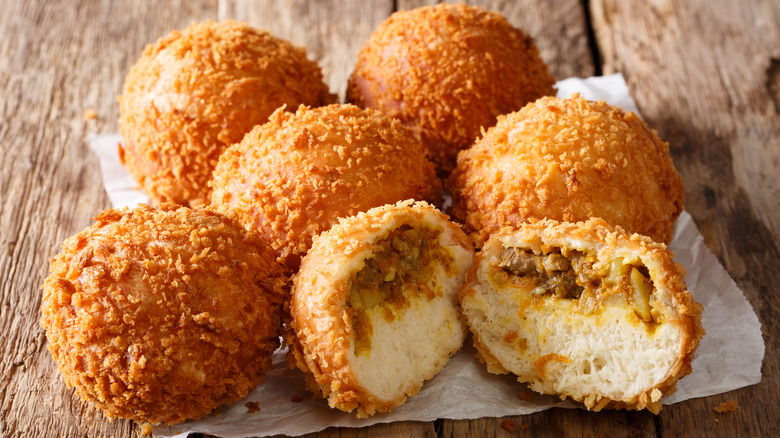30 Japanese Dishes You Need To Try At Least Once
While Japanese cuisine is often condensed into a few dishes (such as sushi and ramen) outside of the country, the wide range of options and the culinary precision at play on the island produce impeccable foods that satisfy all elements of dining. Not only are they flavorful and fresh, but the local diet is also very healthy, BBC Good Food reports. Low rates of cardiovascular disease and obesity, paired with long life expectancy, suggest Japanese food has benefits. The dietary lifestyle and traditional dishes are highly respected within the country and they have officially been acknowledged worldwide. Washoku, the customs involved with the preparation and enjoyment of locally sourced food, was recognized by UNESCO in 2013 as part of the Intangible Cultural Heritage of Humanity.
History and tradition aside, Japan has a bustling culinary scene and it is regularly listed as one of the best food countries in the world (via CNN Travel). Chefs are known to have a special love affair with the country's cuisine, and Today's World Kitchen breaks it down to the skilled artistry, minimalism, high-quality ingredients, and density of Michelin-starred restaurants in Tokyo. Nevertheless, there's no need for fine dining to have an exceptional Japanese meal. The following list highlights 20 Japanese dishes that are worth a taste.
Sushi & Sashimi
This first item actually combines two categories, each with an abundance of options. While they both could be described at length, sushi and sashimi are often served together as two of the more common Japanese dishes available in the U.S. It's easy to forget that Japan is an island — that is until you notice the importance of seafood in the cuisine. Live Japan explains that sashimi consists of thin slices of raw fish served with soy sauce, wasabi, and daikon radish. Tuna, salmon, flounder, shrimp, and squid are all possible protein choices. Note the significant absence of seaweed, rice, and other ingredients — sashimi keeps it simple.
Sushi on the other hand actually translates as vinegared rice, according to Sushi FAQ, but the term now encompasses far more. At its most basic, the rice is paired with raw seafood and rolled up in seaweed for easy handling. However, anyone who's been to a sushi restaurant can attest to the fact that the possible add-ins are almost limitless. While many of the rolls popular outside of Japan can hardly be considered authentic, extras such as fish roe, egg, and vegetables are all possible accompaniments for the raw fish. For the full experience, pair your sushi with pickled ginger, wasabi, and soy sauce.
Tempura
The joys of fried food are shared worldwide, and Japan does it exceptionally well with tempura. According to the Michelin Guide, the origins of the dish actually come from the Portuguese in the 16th century, who made a habit of lightly flouring and frying food. In Japan, fish, vegetables, and meat are all up for grabs — popular favorites include sweet potatoes, shrimp, and mushrooms (via Japan-Guide).
Tempura continued to evolve in the centuries following its introduction, with variations made to the batter content and fat used for frying. Presently, each part of the country prepares the dish with slight differences, and whereas flour, eggs, and water make up the batter in the east, eggs aren't used in the west. The eastern part opts for frying the tempura at high heat in sesame oil and meanwhile, low heat and vegetable oil are the preferred method in the west (via Michelin Guide). Dipping sauces, daikon radish, or just salt are used to season the fried snack. If you've got an appetite, larger meal-sized portions known as tendon are served on top of rice with a sweet and salty sauce, pickles, and miso soup, and the fried delicacy can even accompany noodle soups (via Japan-Guide).
Yakitori
If you can read Japanese, then you'll know that yakitori means grilled bird, according to Food in Japan. Nowadays, the term can be used to describe different skewered meats and vegetables cooked on a grill, although chicken is the most common version of the dish. In fact, yakitori made from chicken offal have traditionally been predominant, though thanks to the sweet soy and mirin glaze commonly used, you probably wouldn't even notice. Other styles of yakitori are simply seasoned with salt, and plenty of regional variations exist. Aside from all things chicken, other typical ingredients include pork, mushrooms, leek, and even seafood.
The skewers are a staple street food snack, which the Michelin Guide indicates has been the case since the late 19th century. As well, Yakitori-ya restaurants that specialize in the grilled snacks are popular with the after-work crowd looking for a quick bite over a pint of beer (via Japan-Guide). Yakitori is also easy to find in izakayas, pub-style restaurants serving small plates. Whether you order a couple of skewers or a dozen, yakitori always makes for a satisfying bite.
Takoyaki
Commonly referred to as octopus balls, takoyaki is a tasty street food you have to try. Octopus meat usually seasoned with pickled ginger and green onions is coated in a wheat flour batter shaped into a ball, Food in Japan explains. Next, the spheres are grilled in a special pan that consists of rounded indents to hold the balls. The cooked balls are topped with takoyaki sauce (a sweet and salty condiment akin to Worcestershire), Japanese mayonnaise, and dried bonito flakes (fish flakes).
It might sound like a lot, but the doughy balls combine the perfect balance of juicy filling with a creamy sweet and salty coating that makes it hard to eat just one. Thankfully they are always sold in multiples so you won't have to settle for less. Live Japan notes that takoyaki is especially popular at festivals so keep an eye out for yatai stands which specialize in the savory treats. Although the snack is said to have originated in Osaka, you can confidently enjoy it across the country and overseas.
Curry rice
While you might not associate curry with Japan, food writer Morieda Takashi notes that most Japanese people eat the dish weekly, regularly listing it among their favorite foods (via Japan Quarterly). Anthropology professor Dr. Merry White tells Vice that curry ended up in Japan via the British Navy, who brought their own version of the Indian dish in late 1800s. Curry gained popularity as it was easy to prepare for large groups, and eventually pre-made curry mixes were sold for quick home cooking (via Vice). Often labeled as golden curry, they are available in supermarkets in the U.S. Compared with typical Indian curries, the Japanese style is thicker, sweeter, and rarely spicy (via Japan-Guide).
Metropolis indicates that stylistic variations are found across the country, as each region perfects its own rendition of the comforting meal. Among the most popular is a curry topped with a breaded pork cutlet that accompanies the sauce and rice. Though the grain is regularly served along with curry, during a time of rice shortage in the late 1800s, a U.S. agriculturist William S. Clark instated the addition of potatoes, forever changing the components of the dish. Apart from potatoes, common ingredients include carrots and meat, often pork or beef (via Japan-Guide). To contrast the rich curry, it is commonly served with sweet pickles or scallions.
Onigiri
If you're looking for a snack that's easy to grab on the go, onigiri could be it. The rice balls (more triangular than round in shape) are incredibly versatile and customizable, and can even be a nourishing meal. In fact, Onigiri Shuttle Korogin indicates that they show up at breakfast, in bento boxes at lunch, and are regularly enjoyed late into the night. There's nothing new about onigiri, and according to The Japan Times, the dish dates back over 2000 years. Kikkoman reports that the convenient format made them popular with troops in the 16th century, and of course, they're ideal for picnics.
Aside from a triangle-shaped mound of rice, there's also a filling hiding inside or displayed more obviously on the surface. Kikkoman lists pickled apricot, plum, grilled fish, roe, meat, or vegetables as popular options, although local and seasonal variations are abundant. The rice is often wrapped with nori leaves (seaweed) to prevent it from drying out, but other types are sprinkled with sesame seeds. The rice balls continue to be tweaked to include Western-influenced fillings, and an onigiri sandwich cross named onigirazu inspired by a manga from the 1980s was even created (via Food Republic).
Ramen
Though many people's introduction to ramen might have been in a cheap instant format, the noodle dish has plenty more to offer. Japan-Guide points out that the soup actually originates from China, though ramen-ya (ramen restaurants) have exploded in popularity in Japan since its introduction. The Guardian even refers to certain cities, such as Fukuoka, as ramen towns, thanks to its 2,000 ramen-ya locations. Although there are countless versions, in essence, ramen consists of a seasoning (tare), broth, noodles, and toppings.
The broth can be made from different bases such as soy sauce (shoyu), soybean (miso), pork bone (tonkotsu), or salt (shio), as per Japan-Guide. In traditional establishments, the broth continues to be regenerated and is never allowed to be entirely used up. In fact, The Guardian indicates the broth at one ramen-ya in Kurume had been simmering for 60 years!
The noodles are usually wheat-based, though variations in stretchiness and thickness are common. Mental Floss explains that ramen noodles are unique for their alkaline pH level, which prevents them from dissolving or getting too soft in the hot broth. Meat lovers will enjoy the fatty hunks of braised pork that top the noodle soup, and corn, seaweed, bamboo, eggs, tofu, and bean sprouts are common extras. It's hard to think of a dish as physically and spiritually nourishing as a piping bowl of ramen brimming with hearty ingredients. Be sure to let your inner child have some fun — slurping is encouraged.
Donburi
The most direct translation of donburi is a bowl, and that's exactly what you'll get. Thankfully, the bowl isn't empty, and Japan-Guide explains that it generally contains a base of rice with popular toppings such as chicken, beef, breaded pork cutlets, raw seafood, grilled eel, eggs, and tempura. For example, katsudon refers to a pork cutlet bowl, and gyudon, one of the more typical options, is a beef bowl. Extra add-ons can vary widely depending on the style of don and whether or not the chef is exploring creative options, but contrasting flavors such as pickled ginger or daikon radishes are common. A sugar, soy sauce, mirin, and dashi-based sauce is often used to season the contents of the bowl (via Live Japan).
The dish is simple, straightforward, and one of Japan's takes on fast food. According to Tokyo Spark, donburi has been around since sometime between the 14th and 16th centuries, and it shows no sign of disappearing thanks to its practical format. The source remarks that chopsticks or a large spoon are both acceptable utensils to consume this dish, so start here if your chopstick technique is a bit rusty.
Tamagoyaki
You're probably familiar with omelets, but how about tamagoyaki? The Japanese version of the egg dish is not only as delicious as you'd expect but it's also aesthetically pleasing. Instead of frying up a flat round omelet in a pan, eggs are whipped with mirin, sugar, and soy sauce and folded over themselves as they cook, Taste Atlas explains. A special rectangular tamagoyaki pan is favored for the preparation, ultimately producing a tubular omelet that is tender and light. The roll is sliced and often served in a bento box, or you might find it with rice as sushi.
Although basic tamagoyaki is kept simple, variations with extra ingredients are also common. For example, the omelet can be stuffed with fried rice and vegetables for a filling dish which Japan Experience notes displays a combination of Japanese and Western influences. According to The Japan Times, the dish gained popularity in the middle of the 20th century when the government pointed out the importance of protein consumption for children, simultaneously inviting farmers to own more chickens and quickly introducing eggs as a cheap source of nourishment.
Soba
Soba noodles are made from buckwheat flour, though wheat flour is regularly added to improve the consistency, according to Japan-Guide. The noodles are similar in width to spaghetti and just like with pasta, fresh and dried versions are available. This is Japan reports that soba noodles as we know them have been around since the 16th to 17th century, leaving plenty of time for the technique to be perfected as a craft.
The dish is served with many variations both hot and cold, with the most basic presentation being cold noodles with a dipping sauce on the side (via Japan-Guide). Soba is commonly paired with broth to make soup, and add-ins such as tofu, eggs, vegetables, and meat provide heft. There are many regional variations as well as a New Year's Eve specialty — toshikoshi soba — eaten to guarantee prosperity as the year changes (via Tokyo Weekender). As per Japan Centre, toshikoshi consists of soba noodles in a dashi, mirin, and soy sauce broth and can certainly be eaten year-round.
If you're looking for more than just a dining experience, you'll want to find a place that serves wanko soba. According to Taste Atlas, the noodles are doled out in a small bowl by the waiter who continues adding bowls until the customer tells them to stop — basically an all-you-can-eat scenario. Some condiments and dipping sauce accompany the endless bowls of noodles to prevent palate fatigue.
Udon
If you're firmly rooted on the noodle path, you'll definitely want to try a bowl of udon. According to the Japan National Tourism Organization, the noodles are made entirely with wheat flour, and much like soba are believed to have been introduced by the Chinese in the 700s. It took almost one thousand years for udon to become popular, though various styles have caught on since. Udon noodles are slightly thicker, softer, and chewier than other types, and buying them fresh maintains their consistency the best (via The Kitchn).
As with soba, udon can be eaten cold dipped in sauce or in a soup. However, the typical preparation is to serve the chewy noodles in a flavorful hot broth, along with toppings such as vegetables, meat, or tempura (via Asia Highlights). Extra seasonings like scallions, seaweed, ginger, and chili peppers can be sprinkled on top to enhance the dish. If you end up in Japan, be sure to try regional udon specialties, as The Smart Local lists multiple variations in styles, including wide flat sheet-like udon.
Sukiyaki
According to The Japan Times, there's a good chance of eating sukiyaki on New Year's Day in Japan. The source describes the beef dish, noting that there are two significant regional distinctions as to the cooking method. In some areas, sukiyaki refers to a beef hot pot cooked with sake, mirin, and sugar, whereas the beef is pan-fried in other preparations, true to its suffix -yaki, which means grilled or fried. In the latter, the thinly sliced beef is cooked with sake, soy sauce, mirin, and sugar, so the flavor profile is quite similar (via Food in Japan).
Both styles are served with vegetables, including mushrooms, cabbage, and green onions, which makes it a warm nourishing meal ideal for cold weather. As for the beef, thin slices of pricey marbled wagyu are preferred, a detail which The Japan Times points out might explain why the dish is traditionally reserved for special occasions. Whether you eat the hot pot version or pan-fried sukiyaki, the nutritious meal is a must-try.
Miso Soup
Miso soup is so much more than a bowl of broth that comes with your sushi or bento box. In fact, Japan Centre notes that the soup is fundamental to the Japanese diet, and the majority of the population eats it once a day. The Chinese are once again responsible for the introduction of miso, and Japan Centre traces the origin back to the 6th or 7th century. The soup is simply made using dashi stock and miso paste, and toppings are added for contrasting textures — or you can add boiling water to a packet of instant miso soup for a decent approximation.
As far as toppings go, wakame seaweed, tofu, mushrooms, and green onions are commonly included. Although you might not have so many miso options in the instant packet format, the paste comes in a range of colors. Made from fermented soybeans, it can be white, yellow, red, brown, or black depending on the preparation and length of the fermentation and aging (via The Kitchn). Typically, darker miso will have a more pungent aroma and infuse more flavor into the broth. Every chef and household has their own miso soup recipe, perfected over time, so trying plenty of different versions is a great way to explore the nuances.
Okonomiyaki
Also known as Japanese pancake or pizza, okonomiyaki is the type of dish you should always say yes to. A culinary specialty in Hiroshima, BBC Travel explains that the cheap meal rose in popularity following the city's uncertain future after being hit by an atomic bomb in 1945. The source notes that okonomiyaki translates as "whatever you like, grilled," which is indeed the essence of the dish. The pancake is made on a hot griddle with batter, fillings, and toppings that make the dish come to life.
BBC Travel explains that there are two distinct styles: one from Hiroshima and the other from Kansai. The former is made with layers of batter, cabbage, bean sprouts, meat, ramen noodles, fried eggs, and the lot is topped with green onions, dried bonito flakes, and seaweed, not to mention okonomiyaki sauce (similar to Worcestershire) and Japanese mayo generously drizzled over top. The Kansai style mixes everything together into a tamer (though equally delicious) concoction and skips out on the noodles. Of course, true to its name you can ask for pretty much anything in your okonomiyaki and there are even restaurants where you have a griddle to make your own.
Gyoza
It's hard to think of a more satisfying dish than dumplings, and gyozas are the version perfected in Japan. However, Taste Atlas explains that the dumplings originally stem from a Chinese dish, though the flavor profile was modified to suit Japanese palates. The bite-sized snacks are commonly served as a side dish with rice or ramen as they are tasty but not overly filling.
The half-moon-shaped pockets are made with a wheat wrapper and filled with minced meat, vegetables, and seasonings. Japan Guide notes that the classic filling consists of minced pork, cabbage, chives, green onion, garlic, ginger, soy sauce, and sesame oil. Nonetheless, endless variations are possible and you might find mushrooms, shishito leaf, shrimp, or even cheese in your gyozas. As for the cooking method, the dumplings are typically pan-fried and quickly steamed, but they can also be boiled and served with broth, or occasionally deep-fried. At service, the hot pockets are dipped into a sauce of vinegar and soy sauce, with a hint of chili oil, according to Live Japan.
Karaage
What meat lover doesn't enjoy fried chicken? Japanese karaage is a delicious version of the classic comfort food, popularized after the second world war (via Japan Experience). As cheap and easy meals were encouraged to feed families on small budgets, chicken made its way to front and center. Karaage isn't just any fried chicken as the meat is first marinated in soy sauce, sake, mirin, garlic, and ginger, assuring a juicy result, 196 Flavors explains. Then, the meat is battered with flour and potato or corn starch and deep-fried for extra crispiness.
At service, Japan-Centre recommends squeezing fresh lemon juice over top and dipping each hot piece of karaage in Japanese mayonnaise. The source also points out that chicken thighs provide the most flavor for the dish, and eliminate the risk of drying out quickly. Curiously, the fried chicken dish is also served cold in bento boxes. Or, make your own karaage don by serving it in a bowl on a bed of rice.
Natto
This dish might be harder to get on board with, but natto is firmly rooted in Japanese cuisine. Live Japan explains that soybeans are fermented and form a specific type of bacteria that produces a sticky stringy texture and a smell that might best be described as acquired. Traditional natto was made by fermenting boiled soybeans wrapped in straw, though nowadays a starter culture is introduced to initiate fermentation (via Encyclopedia of Food Sciences and Nutrition). Once you get past the consistency, you'll realize that a huge part of the dish's appeal is the umami flavor created by the bacteria.
The beans are typically served with rice and sometimes raw egg for a nutritious meal that is praised for its health benefits. Soy sauce and Japanese mustard are typical condiments to season the soybeans, according to Live Japan. Natto is incredibly common in the average Japanese diet, and packaged versions are easily accessible all over the country. Variations in size, stickiness, and beans are available to suit different tastes (via Live Japan).
Teppanyaki
You don't have to go to Japan to experience the delight of teppanyaki. In metropolitan areas worldwide, restaurants specializing in the traditional method of cooking food on a large iron plate can be found. In fact, Taste Atlas points out that although the preparation existed earlier, the first teppanyaki restaurant opened in Japan in 1945, and just under 20 years later, a similar establishment was opened in New York City.
The source explains that teppanyaki means iron plate grill, which is the basis for a wide range of foods prepared this way. Whether it's meat, seafood, vegetables, or noodles, the food is cooked on an iron plate by your table, giving the consumer front row seats to the show. It's worth mentioning that Umami Insider indicates the performative aspect of teppanyaki is far more common in the U.S., and restaurants providing a similar experience in Japan have a heavy Western influence. In fact, the original Japanese teppanyaki restaurant Misono owed its formula to the American soldiers stationed in Kobe at the end of World War II, per Japan Today. Think of it as the ultimate grilled meal highlighting East meets West.
Tonkatsu
There's no doubt that Western influences have marked modern Japanese cuisine, and tonkatsu is one such example. The dish consists of a breaded and deep-fried pork cutlet and it has fans across the country, according to Taste Atlas. If you noticed a similarity with the French veal specialty côtelette, you're not wrong. Live Japan explains tonkatsu is somewhat of a blend of tempura and the French breaded meat dish.
Food in Japan notes that the batter is commonly made from a combination of flour and egg powder, which provides a better consistency. Sliced and served with rice and cabbage, nestled between two slices of bread, enjoyed on top of a steaming bowl of ramen, or even served with curry, there are endless ways to enjoy tonkatsu. Don't miss out on the traditional seasoning, which Taste Atlas indicates is a sweet and savory mix of mustard and a sauce akin to Worcestershire.
Shabu-Shabu
There's no shortage of warm comforting dishes in Japanese cuisine, and shabu-shabu is high on the list. Great Taste notes that like various foods in Japan, the origins stretch back to a Chinese dish. According to Live Japan, the hot pot preparation is often made at home, since once you have the right equipment it's incredibly straightforward. You'll mainly need a large pot that fits plenty of broth, thin slices of meat, and vegetables. Beef and pork are common but other proteins like tofu or seafood can also be prepared, Great Taste indicates. As for the broth, the source points out that miso, lemongrass, mushroom, and kelp are all up for grabs, making the variations endless.
We're not talking about a long slow cooking process here either. Live Japan describes the act of swishing meat through the boiling broth a few times before quickly removing it to avoid overcooking. Once the food is ready, it's served with an assortment of dipping sauces. Sesame or ponzu (citrus-based) sauces are favored, and soy sauce is always on the table.
Yakiniku
Yakiniku captures a wide range of items, per its translation meaning grilled meat (via South China Morning Post). Its post-World War II origins come from Western barbecue traditions as well as Korean grilled specialties like bulgogi and galbi. Designated yakiniku restaurants offer a ventilated setting to enjoy the delight of barbecue flavors. Quality is of prime importance, and wagyu beef is prioritized above all types of meat. Still, you'll find plenty of other options like short ribs, sirloin, tongue, sausage, chicken, pork, lamb, seafood, and vegetables (via Tokyo Restaurants Guide).
Given the caliber of the foundational ingredients, very minimal seasoning is added — often only salt and miso — in order to let the meat shine. Nonetheless, modern chefs are paving the way for experimental flavors and both pre-grilling and dipping sauces can be involved in the preparation. Tokyo Restaurants Guide recommends eating the grilled meat with a leafy green lettuce for a fresh and crunchy contrast to the umami-rich meat.
Fugu
You might think you're a daring person, but would you eat something that could potentially kill you? Anyone who's savoring fugu is playing that game of Russian roulette. Also known as blowfish, fugu contains a neurotoxin that halts nerve impulses throughout the body (via The New York Times). Paralysis and death follow once your heart stops responding to nerve signals.
Although it is now synonymous with luxury, fugu was originally consumed due to food shortages. The dish must be prepared by a licensed chef who has spent two to three years learning how to precisely extract the toxic components. The Guardian reports that most deaths from blowfish occur when people try to prepare it themselves — there's a reason why it requires professional training.
According to The New York Times, farmed fugu has now become more common, resulting in fish with no detectable traces of toxins. While this certainly eliminates the previous risk associated with consuming it, it also removes the chef's impressive feat, as well as the weighty notion of being in close quarters with death. To that end, wild fugu is still considered far more exclusive.
If you're ready to dive into the unknown, fugu is typically served sashimi-style in thin slices or in a hot pot dish (via Ministry of Foreign Affairs of Japan). It is rich in collagen, with a firm yet delicately chewy texture and subtle sweetness. Enjoy it served with ponzu dipping sauce, green onions, daikon, and chili peppers.
Unagi
Offer someone eel and they might be a bit wary; serve them a plate of unagi and they're bound to ask for more. This Japanese grilled eel delicacy is described by Savor Japan as a must-try dish when visiting the country. Whether you try it on a trip to Japan or at a local Japanese restaurant, it's sure to win you over.
Viewed as a high-end gourmet product, grilled freshwater eel offers the perfect balance of fatty, smoky, and charred flavors balanced by the sweet sauce it's commonly basted with. Find it served with rice, as a nigiri, or simply grilled on a skewer. It also often comes with a side of powdered sansho, a Japanese pepper that contrasts perfectly with the fatty eel.
Per Savor Japan, saltwater-residing eel called anago may sometimes be confused for unagi, but the former contains far less fatty matter, resulting in a milder flavor and texture. In line with their fatty consistency, the outlet explains that eel tend to fatten up as autumn progresses and spawning time approaches. That being said, certain cultural beliefs and traditions make this dish especially popular in the summertime as it is thought to improve stamina and the ability to deal with hot temperatures (via Japan Guide).
Oden
If you're in need of a warm nourishing dish, oden is meant for you. The meal comes in a number of regional variations, but at its core, it consists of a soy-based broth with added ingredients (via Japan Centre). Given its regional specificity, oden is an excellent meal to try throughout Japan in order to appreciate the ingredients that each area has to offer.
Noodles, fried tofu cubes, tofu cakes, fish cakes, eggs, assorted vegetables, and plenty more can be mixed in to beef up the broth. In the Okinawa region, pig feet are a common addition, whereas other areas add sausage, chicken wings, or seafood. Similarly, regional distinctions abound with regard to the broth content. Seaweed, mushroom, miso, beef, and soy sauce-rich broths are all available somewhere.
Don't be surprised if your bowl of oden comes with sake, as the two are regularly paired together. According to Food in Japan, it's not uncommon to find this comforting soup sold streetside, customizable based on your preference. Or, try your hand at whipping up your own recipe at home.
Hambāgu
Hamburgers might not be the first dish that comes to mind when you think of Japanese cuisine, but the Asian country does have its own fusion rendition. Originating from a tradition of combining Western and Asian cuisine, hambāgu is not quite your average fast food burger. Its name may be derived from the word hamburger, but it's presented as hamburger steak.
Skip the bread, condiments, and loaded toppings and you're left with a well-seasoned ground beef patty held together with breadcrumbs, onions, and egg (via Japan National Tourism Association). According to Otaku Food, adding ground pork to the mix enhances the final product's savory flavor and juicy consistency.
Side dishes veer away from the classic fry combo, and instead typically consist of rice or salad, along with ponzu, pepper, or demi-glace dipping sauce. It's a common protein in bento boxes, and extra toppings like sauteed vegetables are not out of place. Restaurants looking to cater to Western palates will even venture into melted cheese territory, making hambāgu a low-carb take on a drive-thru favorite.
Nikujaga
Complex recipes have their place in a culture's cuisine, yet there's nothing quite like a basic bare-bones dish. Nikujaga is Japan's version of the classic meat and potato duo, and it is most likely an adaptation of traditional European beef stews, according to Taste Atlas. Don't expect huge chunks of meat and a few sparse potatoes; the outlet explains that Japanese dishes tend to use meat as a flavoring agent rather than a bulky addition.
Nikujaga is most commonly prepared with beef, followed by pork. The meat is typically sliced up thinly and lightly cooked in a mixture of soy sauce, sake, and mirin to make a stock infused with a delicate and salty taste. Potatoes and other foundational ingredients like carrots and onions are incorporated into this nourishing stew. Food in Japan notes that yam noodles (shirataki) sometimes make an appearance too, demonstrating that nikujaga is a versatile dish that will keep you satisfied.
Yakisoba
Yakisoba is easily found on a global scale, which confirms its world-conquering status as described by Yabai. The direct translation means fried buckwheat noodles (soba), which hints at the fact that the true origin of the dish is China, the source of the plant.
Taste Atlas compares the dish to chow mein, and indeed you can add an assortment of meat and vegetables to this hearty noodle dish. Japanese versions tend to include ingredients like pork, carrots, onions, and cabbage. The sauce is also a noteworthy component mixed in to coat everything at the end. It's typically oyster and soy-sauce based and much like Worcestershire sauce in both flavor and texture. Perhaps less common in Western renditions are the toppings; ground seaweed, pickled ginger, mayo, and fish flakes are all possible candidates.
Nowadays, you're likely to find yakisoba vendors on street corners around Japan, and the international popularity of Nissin instant noodles has reached epic proportions. Of course, there's far more to yakisoba than its instant versions, and given the easy preparation, it's a good dish to whip up at home. While you're at it, you might want to try yakisoba pan, a noodle sandwich made in a soft roll (via The Guardian).
Chawanmushi
Whereas some dishes are exciting for their stark contrast of textures, chawanmushi consists of a silky smooth custard that melts in your mouth. MasterClass explains that eggs are whisked with dashi stock and mirin (and sometimes soy sauce and salt), then steamed in a teacup for a subtle-yet-expertly flavored result. According to Kikkoman, this savory dish was once a favorite at banquets in the 18th century. Its simple preparation, adaptable nature, and luxuriously comforting flavor make it an all-around winner.
While the base dish only entails eggs, optional ingredients can be added to bulk up the meal. For example, small pieces of chicken, shrimp, vegetables, parsley, sea urchin, and roe are all possible extras to infuse the creamy dish with more flavor. Proteins and vegetables are layered on the bottom of the cup and topped with the egg mixture for consistent cooking. True to its banquet roots, Kikkoman notes that chawanmushi can be found in Japanese fine dining or simply whisked up at home.
Buta-no-shogayaki
Buta-no-shogayaki comes off as a bit of a mouthful, but all you really need to know is that this dish consists of another kind of mouthful — primarily pork belly, ginger, and onions. Simply referred to as ginger pork, Live Japan describes a contrast of sweet and spicy flavors that unite in this wholesome meat-centric dish. Of course, serving the thinly sliced meat with steamed white rice enhances the pairing by letting it shine in each bite.
Thanks to ginger's health properties (per Healthline), this dish is invigorating and suitable for any occasion. Apart from the zesty ginger, the pork is seasoned with a sweet and salty mixture of mirin, soy sauce, and sugar (via Parts Unknown). As the fatty pork belly cooks, it produces subtle caramelization, leading to a borderline decadent final result. Yet ultimately, the weighty presence of ginger balances it out to keep the taste pleasantly refreshing and bright.
Curry Bread
Japanese curry is a rich and flavorful preparation of carrots, potatoes, meat, and seasoning, typically served with rice. That being said, there are many variations as to how you can savor the stew, and curry bread, aka karepan, is among our favorites. Back in April 2020, The New Yorker described it as "a food fit for quarantine," partly due to its undeniably comforting nature, and also because it's a bit of a process to make — not really the kind of dish you'd whip up as a quick weeknight dinner.
If you do venture to preparing curry bread yourself, then you'll be rewarded for your efforts with warm yeasty aromas and a perfectly crunchy panko exterior that makes way for the curry filling. In Japan, the savory snack is conveniently sold at bakeries, markets, and street carts. The original creation can be traced back to Cattlea Bakery in Tokyo, where curry bread was first fried up in 1927 (via Tokyo Cheapo). Deep frying was not so common in Japan at the time, and the resulting snack became a sort of Western fusion treat that has remained popular for almost a century.
